Modeling and Optimization of Date Palm Fiber Reinforced Concrete Modified with Powdered Activated Carbon under Elevated Temperature
Abstract
:1. Introduction
2. Materials and Methods
2.1. Materials
2.2. Mix Proportioning by Response Surface Methodology (RSM)
2.3. Sample Preparations and Casting
2.4. Test Methods
3. Results and Discussions
3.1. Mass Loss
3.1.1. Analysis of Variance for Mass Loss
3.1.2. Diagnostic Plots for Weight Loss Model
3.1.3. Effect of PAC and Temperature on Mass Loss
3.2. Compressive Strength
3.2.1. Analysis of Variance for Compressive Strengths Models
3.2.2. Diagnostic Plots for Compressive Strengths Models
3.2.3. Effect of PAC and Temperature on Compressive Strengths
3.3. Multi-Objective Optimization
3.4. Model Validation
4. Conclusions
- (1)
- The addition of DPF and PAC escalated the mass loss of the DPF-reinforced concrete under high temperatures.
- (2)
- DPF addition led to a significant loss in compressive strength of the concrete under high temperatures, where the loss in strength was more pronounced when the concrete was subjected to a higher temperature above 300 °C.
- (3)
- PAC incorporation as additive by weight of cement to the DPF reinforced concrete mitigated the loss in strengths of the concrete when subjected to high temperatures up to 600 °C. This was noticed as the addition of PAC improved the residual and relative strengths of the DPF-reinforced concrete when heated to a temperature of up to 600 °C.
- (4)
- The mathematical models developed using RSM to predict the performance of the DPF-reinforced concrete under high temperatures in form of weight loss, relative strength, and residual compressive strengths were all very significant. The models have a very high degree of correlation and predictability. These models were validated experimentally and found to have an average error of less than 8%.
- (5)
- The highest compressive and relative strengths and lowest mass loss for the DPF under high temperature were achieved using the optimum combinations of 1% DPF and 2.27% PAC as additive by weight of cementitious materials, subjected to a temperature of 300 °C for 2 h. exposure.
- (6)
- It is recommended to use PAC as an additive in natural fiber-reinforced concrete under high temperatures to partially mitigate the loss in strength of the concrete.
Author Contributions
Funding
Institutional Review Board Statement
Informed Consent Statement
Data Availability Statement
Acknowledgments
Conflicts of Interest
References
- Alyousef, R.; Ali, B.; Mohammed, A.; Kurda, R.; Alabduljabbar, H.; Riaz, S. Evaluation of mechanical and permeability characteristics of microfiber-reinforced recycled aggregate concrete with different potential waste mineral admixtures. Materials 2021, 14, 5933. [Google Scholar] [CrossRef]
- Khan, M.S.; Abbas, H. Performance of concrete subjected to elevated temperature. Eur. J. Environ. Civ. Eng. 2016, 20, 532–543. [Google Scholar] [CrossRef]
- Yu, J.; Yu, K.; Lu, Z. Residual fracture properties of concrete subjected to elevated temperatures. Mater. Struct. 2012, 45, 1155–1165. [Google Scholar] [CrossRef]
- Khaliq, W.; Kodur, V. Thermal and mechanical properties of fiber reinforced high performance self-consolidating concrete at elevated temperatures. Cem. Concr. Res. 2011, 41, 1112–1122. [Google Scholar] [CrossRef]
- Novak, J.; Kohoutkova, A. Mechanical properties of concrete composites subject to elevated temperature. Fire Saf. J. 2018, 95, 66–76. [Google Scholar] [CrossRef]
- Bingöl, A.F.; Gül, R. Effect of elevated temperatures and cooling regimes on normal strength concrete. Fire Mater. Int. J. 2009, 33, 79–88. [Google Scholar] [CrossRef]
- Arioz, O. Effects of elevated temperatures on properties of concrete. Fire Saf. J. 2007, 42, 516–522. [Google Scholar] [CrossRef]
- Demirel, B.; Keleştemur, O. Effect of elevated temperature on the mechanical properties of concrete produced with finely ground pumice and silica fume. Fire Saf. J. 2010, 45, 6–8. [Google Scholar] [CrossRef] [Green Version]
- Zega, C.; Di Maio, A. Recycled concrete exposed to high temperatures. Mag. Concr. Res. 2006, 58, 675–682. [Google Scholar] [CrossRef]
- Ibrahim, Y.E.; Adamu, M.; Marouf, M.L.; Ahmed, O.S.; Drmosh, Q.; Malik, M.A. Mechanical Performance of Date-Palm-Fiber-Reinforced Concrete Containing Silica Fume. Buildings 2022, 12, 1642. [Google Scholar] [CrossRef]
- Ali, B.; Fahad, M.; Mohammed, A.S.; Ahmed, H.; Elhag, A.B.; Azab, M. Improving the performance of recycled aggregate concrete using nylon waste fibers. Case Stud. Constr. Mater. 2022, 17, e01468. [Google Scholar] [CrossRef]
- Koksal, F.; Kocabeyoglu, E.T.; Gencel, O.; Benli, A. The effects of high temperature and cooling regimes on the mechanical and durability properties of basalt fiber reinforced mortars with silica fume. Cem. Concr. Compos. 2021, 121, 104107. [Google Scholar] [CrossRef]
- Talaei, M.; Mostofinejad, D. Mechanical properties of fiber-reinforced concrete containing waste porcelain aggregates under elevated temperatures. Constr. Build. Mater. 2021, 289, 122854. [Google Scholar] [CrossRef]
- Aluko, O.G.; Yatim, J.M.; Kadir, M.A.A.; Yahya, K. A review of properties of bio-fibrous concrete exposed to elevated temperatures. Constr. Build. Mater. 2020, 260, 119671. [Google Scholar] [CrossRef]
- Onuaguluchi, O.; Banthia, N. Plant-based natural fibre reinforced cement composites: A review. Cem. Concr. Compos. 2016, 68, 96–108. [Google Scholar] [CrossRef]
- Karimah, A.; Ridho, M.R.; Munawar, S.S.; Adi, D.S.; Ismadi; Damayanti, R.; Subiyanto, B.; Fatriasari, W.; Fudholi, A. A review on natural fibers for development of eco-friendly bio-composite: Characteristics, and utilizations. J. Mater. Res. Technol. 2021, 13, 2442–2458. [Google Scholar] [CrossRef]
- Zhang, D.; Tan, K.H.; Dasari, A.; Weng, Y. Effect of natural fibers on thermal spalling resistance of ultra-high performance concrete. Cem. Concr. Compos. 2020, 109, 103512. [Google Scholar] [CrossRef]
- Ozawa, M.; Kim, G.-Y.; Choe, G.-C.; Yoon, M.-H.; Sato, R.; Rokugo, K. Thermal properties of jute fiber concrete at high temperature. J. Struct. Fire Eng. 2016, 7, 182–192. [Google Scholar] [CrossRef]
- Gonzalez-Lopez, L.; Claramunt, J.; Haurie, L.; Ventura, H.; Ardanuy, M. Study of the fire and thermal behaviour of façade panels made of natural fibre-reinforced cement-based composites. Constr. Build. Mater. 2021, 302, 124195. [Google Scholar] [CrossRef]
- Wei, J.; Meyer, C. Degradation mechanisms of natural fiber in the matrix of cement composites. Cem. Concr. Res. 2015, 73, 1–16. [Google Scholar] [CrossRef]
- Grubeša, I.N.; Marković, B.; Gojević, A.; Brdarić, J. Effect of hemp fibers on fire resistance of concrete. Constr. Build. Mater. 2018, 184, 473–484. [Google Scholar] [CrossRef]
- Gencel, O.; Nodehi, M.; Bayraktar, O.Y.; Kaplan, G.; Benli, A.; Gholampour, A.; Ozbakkaloglu, T. Basalt fiber-reinforced foam concrete containing silica fume: An experimental study. Constr. Build. Mater. 2022, 326, 126861. [Google Scholar] [CrossRef]
- Jameel, M.S.; Raza, A.; El Ouni, M.H.; Alashker, Y. The compressive and tensile behavior of polypropylene fibers and activated fly ash incorporated concrete at elevated temperatures. Eur. J. Environ. Civ. Eng. 2023, 27, 794–811. [Google Scholar] [CrossRef]
- Yonggui, W.; Shuaipeng, L.; Hughes, P.; Yuhui, F. Mechanical properties and microstructure of basalt fibre and nano-silica reinforced recycled concrete after exposure to elevated temperatures. Constr. Build. Mater. 2020, 247, 118561. [Google Scholar] [CrossRef]
- Mahapatra, C.K.; Barai, S.V. Temperature impact on residual properties of self-compacting based hybrid fiber reinforced concrete with fly ash and colloidal nano silica. Constr. Build. Mater. 2019, 198, 120–132. [Google Scholar] [CrossRef]
- Sjostrom, S.; Durham, M.; Bustard, C.J.; Martin, C. Activated carbon injection for mercury control: Overview. Fuel 2010, 89, 1320–1322. [Google Scholar] [CrossRef]
- Liu, J.; Nie, X.; Zeng, X.; Su, Z. Long-term leaching behavior of phenol in cement/activated-carbon solidified/stabilized hazardous waste. J. Environ. Manag. 2013, 115, 265–269. [Google Scholar] [CrossRef] [PubMed]
- Horgnies, M.; Dubois-Brugger, I.; Gartner, E. NOx de-pollution by hardened concrete and the influence of activated charcoal additions. Cem. Concr. Res. 2012, 42, 1348–1355. [Google Scholar] [CrossRef]
- Horgnies, M.; Serre, F.; Dubois-Brugger, I.; Gartner, E. NOx De-pollution using activated charcoal concrete—From laboratory experiments to tests with prototype garages. Cem. Concr. Res. 2014, 42, 1348–1355. [Google Scholar] [CrossRef]
- Elmouwahidi, A.; Zapata-Benabithe, Z.; Carrasco-Marín, F.; Moreno-Castilla, C. Activated carbons from KOH-activation of argan (Argania spinosa) seed shells as supercapacitor electrodes. Bioresour. Technol. 2012, 111, 185–190. [Google Scholar] [CrossRef]
- Na, S.; Lee, S.; Youn, S. Experiment on activated carbon manufactured from waste coffee grounds on the compressive strength of cement mortars. Symmetry 2021, 13, 619. [Google Scholar] [CrossRef]
- Zheng, C.; Liu, Z.; Xu, J.; Li, X.; Yao, Y. Compressive strength and microstructure of activated carbon-fly ash cement composites. Chem. Eng. Trans. 2017, 59, 475–480. [Google Scholar]
- Adamu, M.; Alanazi, F.; Ibrahim, Y.E.; Alanazi, H.; Khed, V.C. A Comprehensive Review on Sustainable Natural Fiber in Cementitious Composites: The Date Palm Fiber Case. Sustainability 2022, 14, 6691. [Google Scholar] [CrossRef]
- Al-Oqla, F.M.; Alothman, O.Y.; Jawaid, M.; Sapuan, S.; Es-Saheb, M. Processing and properties of date palm fibers and its composites. Biomass Bioenergy Process. Prop. 2014, 1–25. [Google Scholar] [CrossRef]
- Belakroum, R.; Gherfi, A.; Kadja, M.; Maalouf, C.; Lachi, M.; El Wakil, N.; Mai, T.H. Design and properties of a new sustainable construction material based on date palm fibers and lime. Constr. Build. Mater. 2018, 184, 330–343. [Google Scholar] [CrossRef]
- Lahouioui, M.; Arfi, R.B.; Fois, M.; Ibos, L.; Ghorbal, A. Investigation of fiber surface treatment effect on thermal, mechanical and acoustical properties of date palm fiber-reinforced cementitious composites. Waste Biomass Valorization 2020, 11, 4441–4455. [Google Scholar] [CrossRef]
- Benaniba, S.; Driss, Z.; Djendel, M.; Raouache, E.; Boubaaya, R. Thermo-mechanical characterization of a bio-composite mortar reinforced with date palm fiber. J. Eng. Fibers Fabr. 2020, 15, 1558925020948234. [Google Scholar] [CrossRef]
- Kriker, A.; Debicki, G.; Bali, A.; Khenfer, M.; Chabannet, M. Mechanical properties of date palm fibres and concrete reinforced with date palm fibres in hot-dry climate. Cem. Concr. Compos. 2005, 27, 554–564. [Google Scholar] [CrossRef]
- Boumhaout, M.; Boukhattem, L.; Hamdi, H.; Benhamou, B.; Nouh, F.A. Thermomechanical characterization of a bio-composite building material: Mortar reinforced with date palm fibers mesh. Constr. Build. Mater. 2017, 135, 241–250. [Google Scholar] [CrossRef]
- ASTM C150/C150M; Standard Specification for Portland Cement. ASTM International: West Conshohocken, PA, USA, 2022.
- Montgomery, D.C. Design and Analysis of Experiments; John Wiley & Sons: Hoboken, NJ, USA, 2017. [Google Scholar]
- ACI 211.1R; Standard Practice for Selecting Proportions for Normal, Heavyweight, and Mass Concrete. American Concrete Institute: Farmington Hills, MI, USA, 2002.
- ASTM C192/C192M; Standard Practice for Making and Curing Test Specimens in the Laboratory. ASTM: West Conshohocken, PA, USA, 2015.
- BS EN 12390-3; Testing Hardened Concrete. Compressive Strength of Test Specimens. British Standard Institution: London, UK, 2009.
- ASTM International. Design-expert 11 User’s Guide-response Surface Methods (RSM) Tutorials-Section 6. Stat-Ease. Available online: https://www.statease.com/docs/v11/tutorials/ (accessed on 27 January 2023).
- Maanser, A.; Benouis, A.; Ferhoune, N. Effect of high temperature on strength and mass loss of admixtured concretes. Constr. Build. Mater. 2018, 166, 916–921. [Google Scholar] [CrossRef]
- Adamu, M.; Haruna, S.I.; Ibrahim, Y.E.; Alanazi, H. Evaluation of the mechanical performance of concrete containing calcium carbide residue and nano silica using response surface methodology. Environ. Sci. Pollut. Res. 2022, 29, 67076–67102. [Google Scholar] [CrossRef] [PubMed]
- Behnood, A.; Ziari, H. Effects of silica fume addition and water to cement ratio on the properties of high-strength concrete after exposure to high temperatures. Cem. Concr. Compos. 2008, 30, 106–112. [Google Scholar] [CrossRef]
- Castillo, C. Effect of Transient High Temperature on High-Strength Concrete; Rice University: Houston, TX, USA, 1987. [Google Scholar]
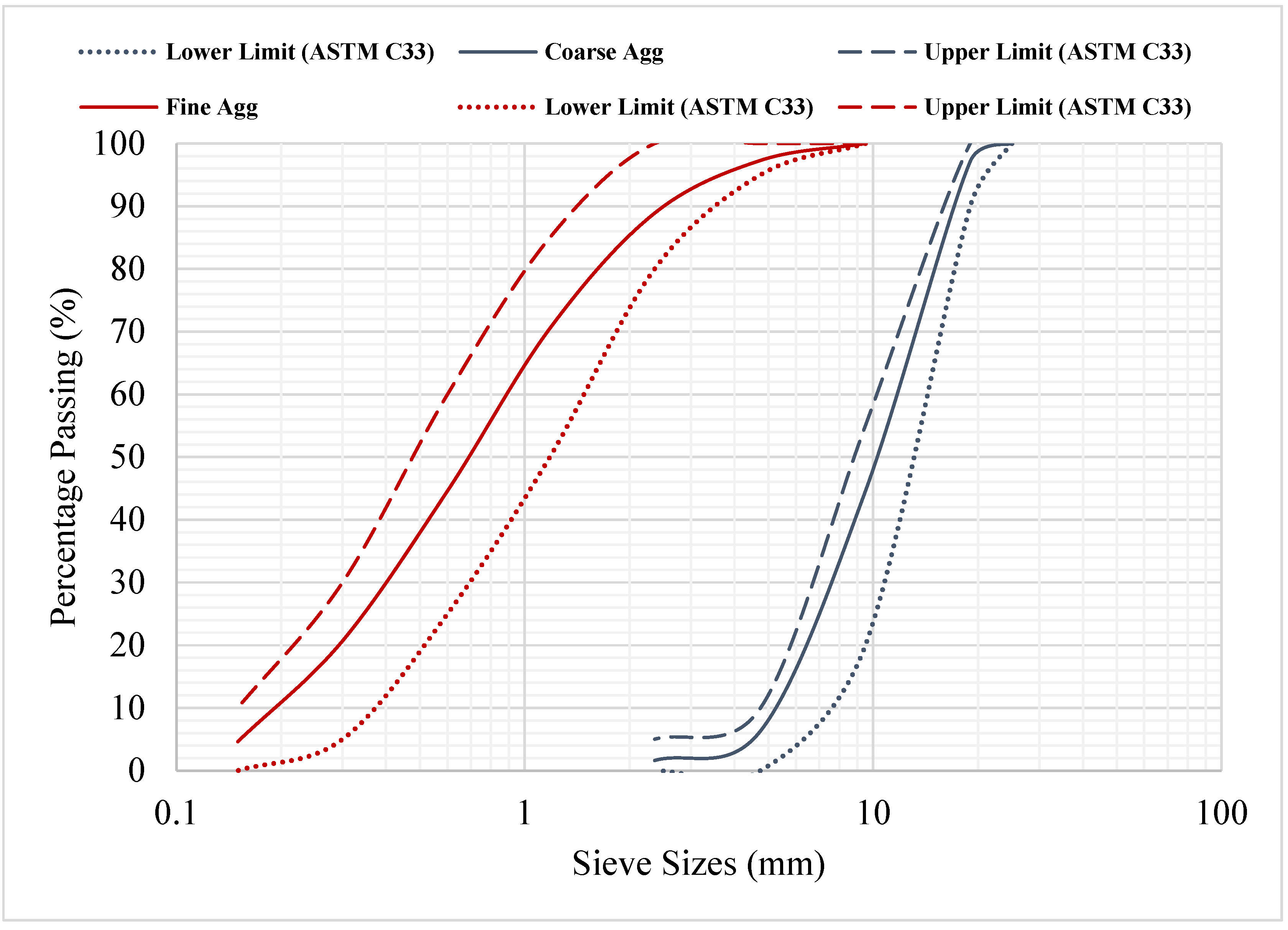
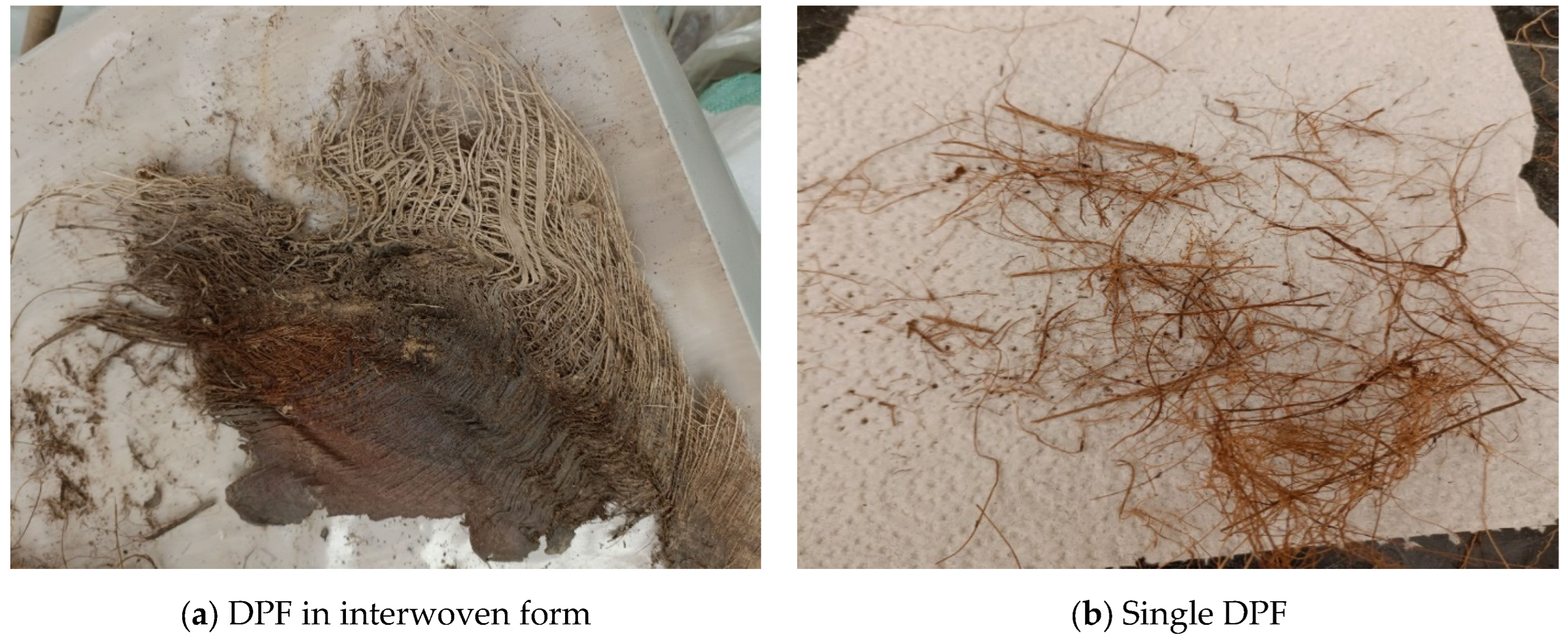
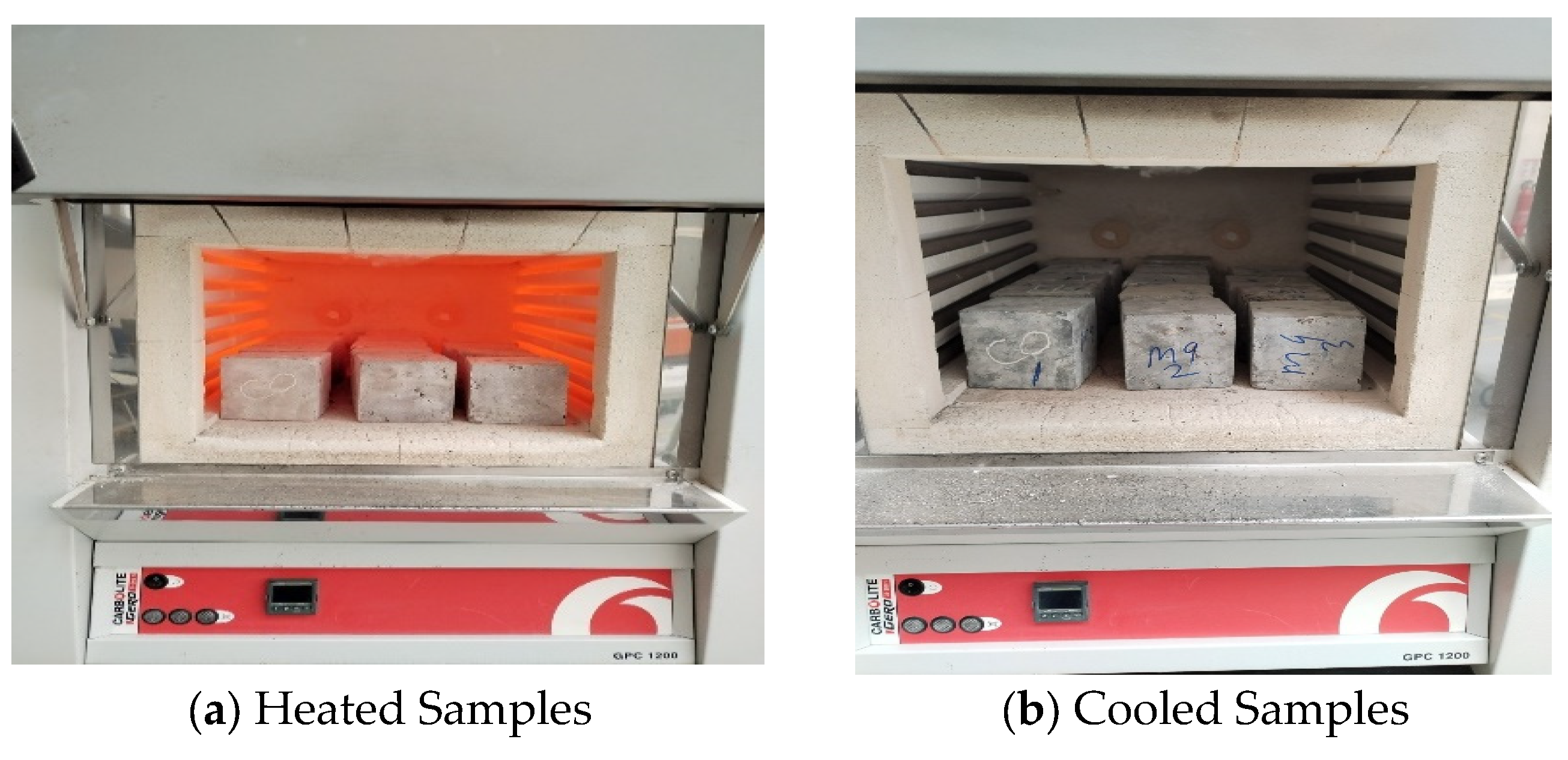
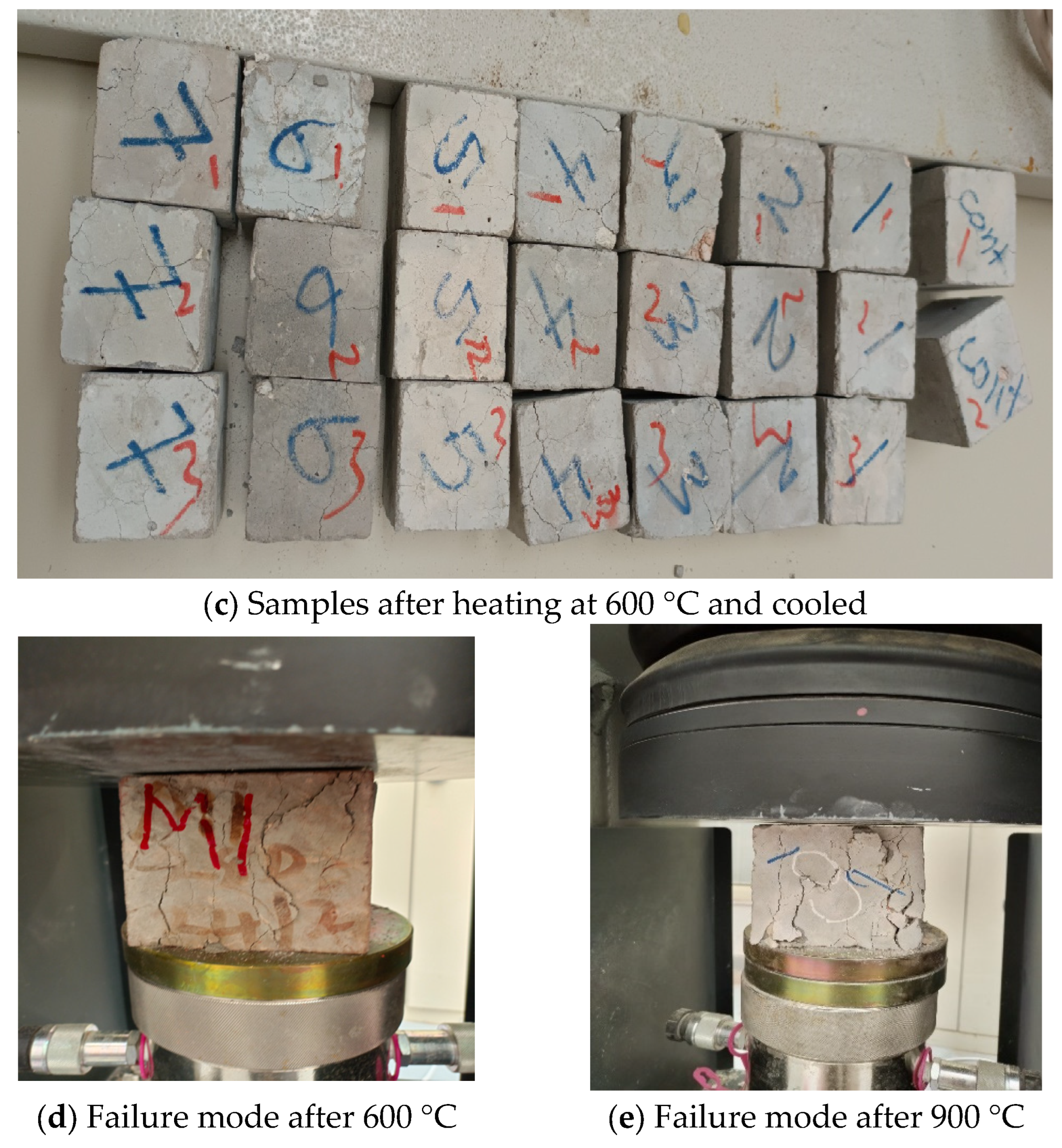
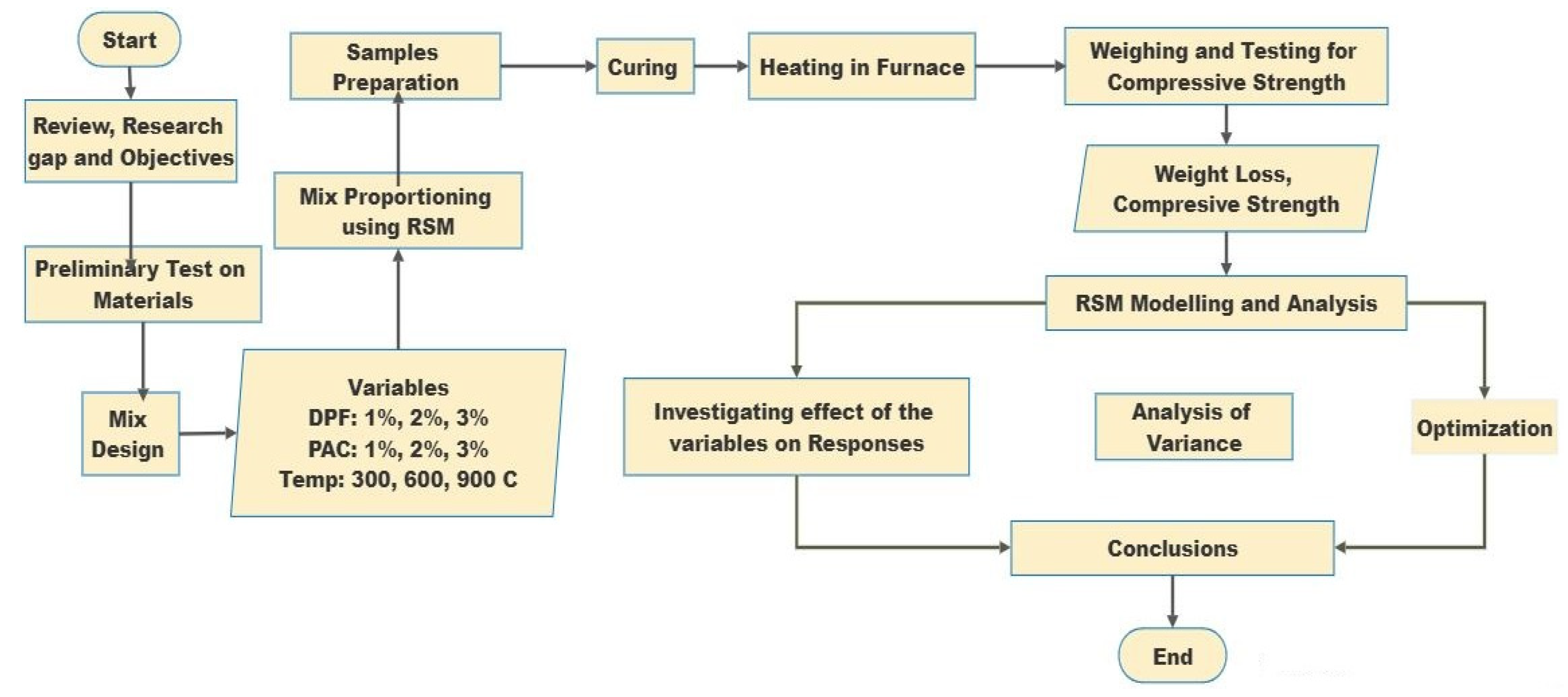
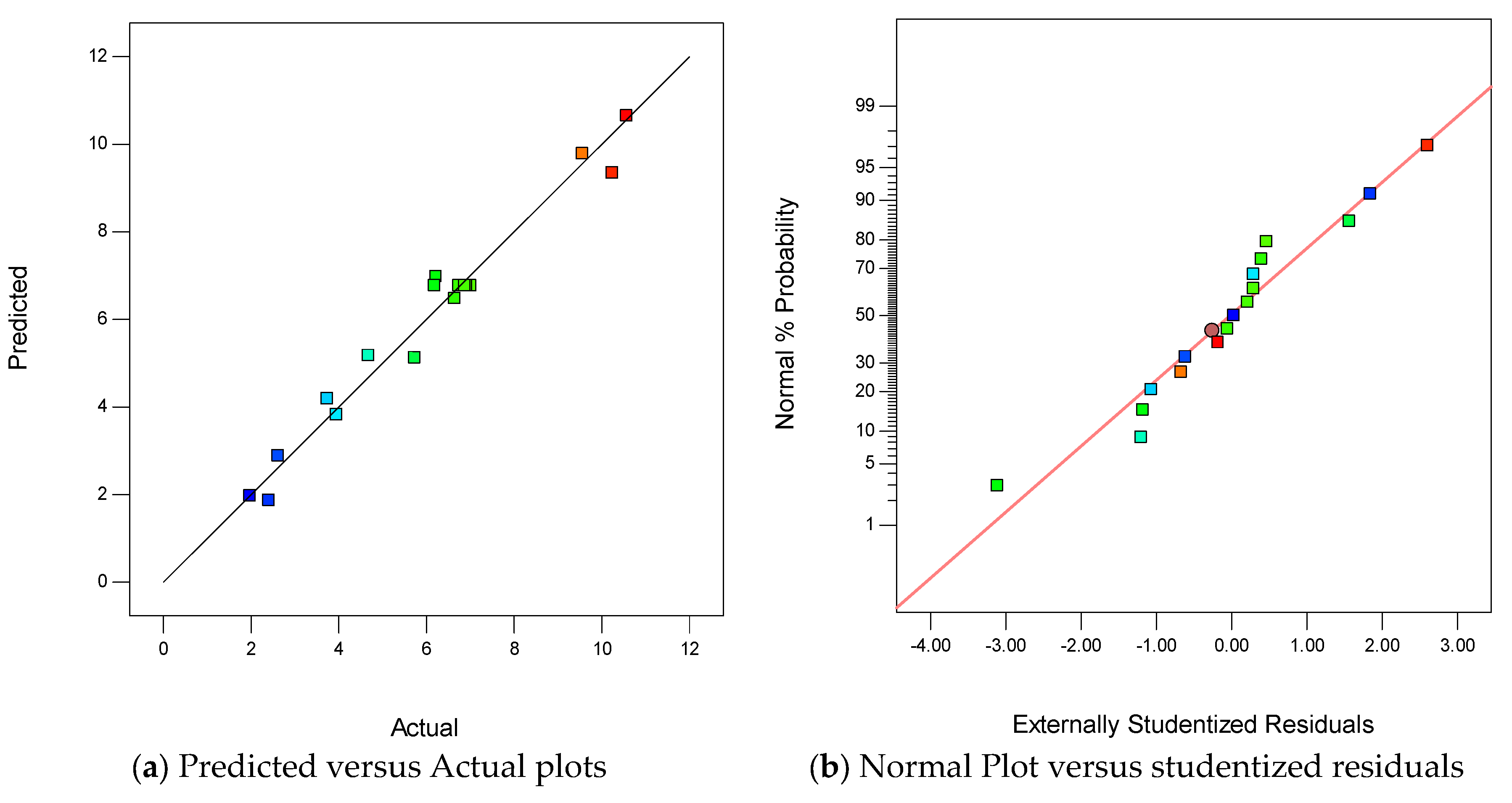
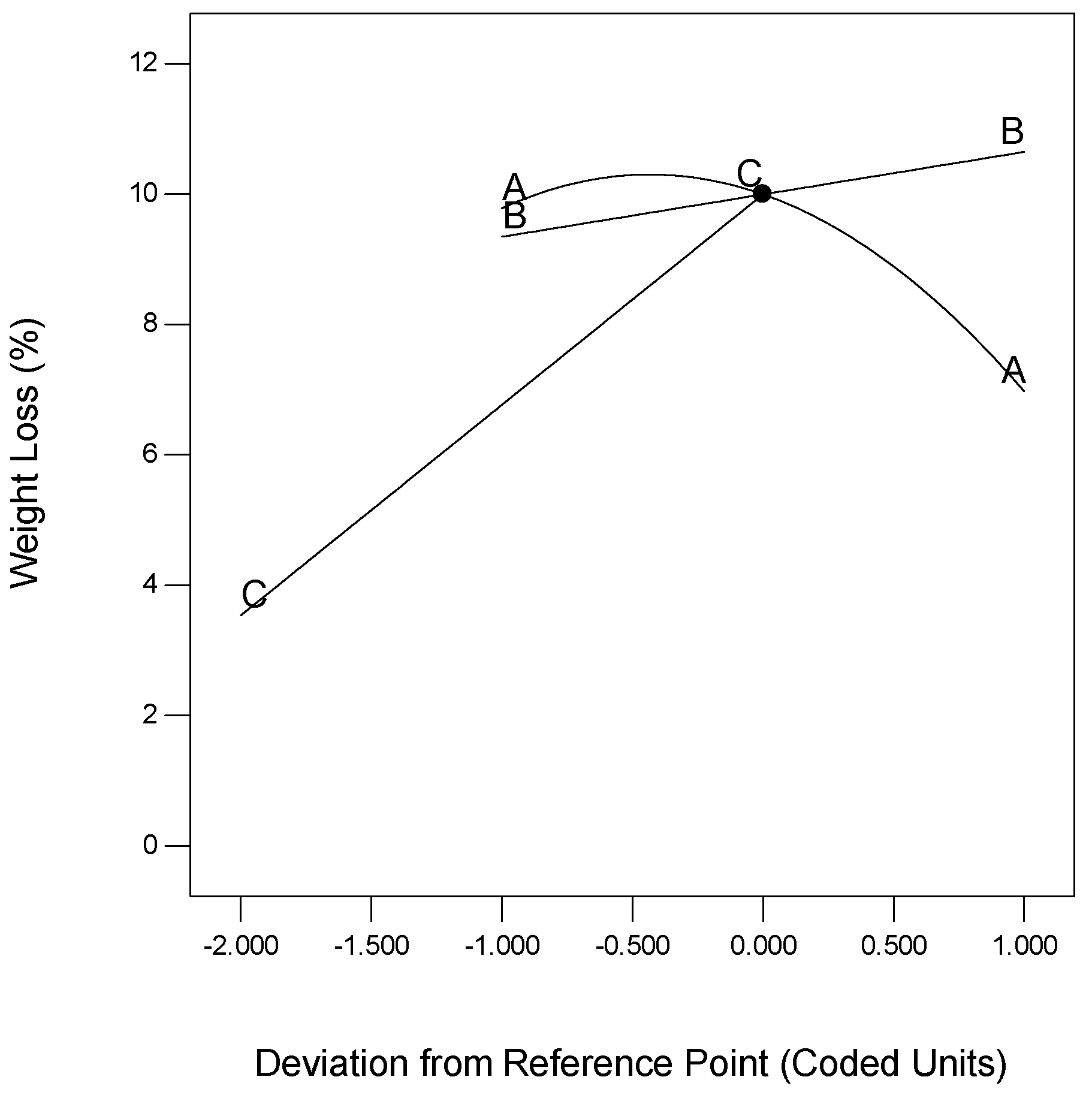
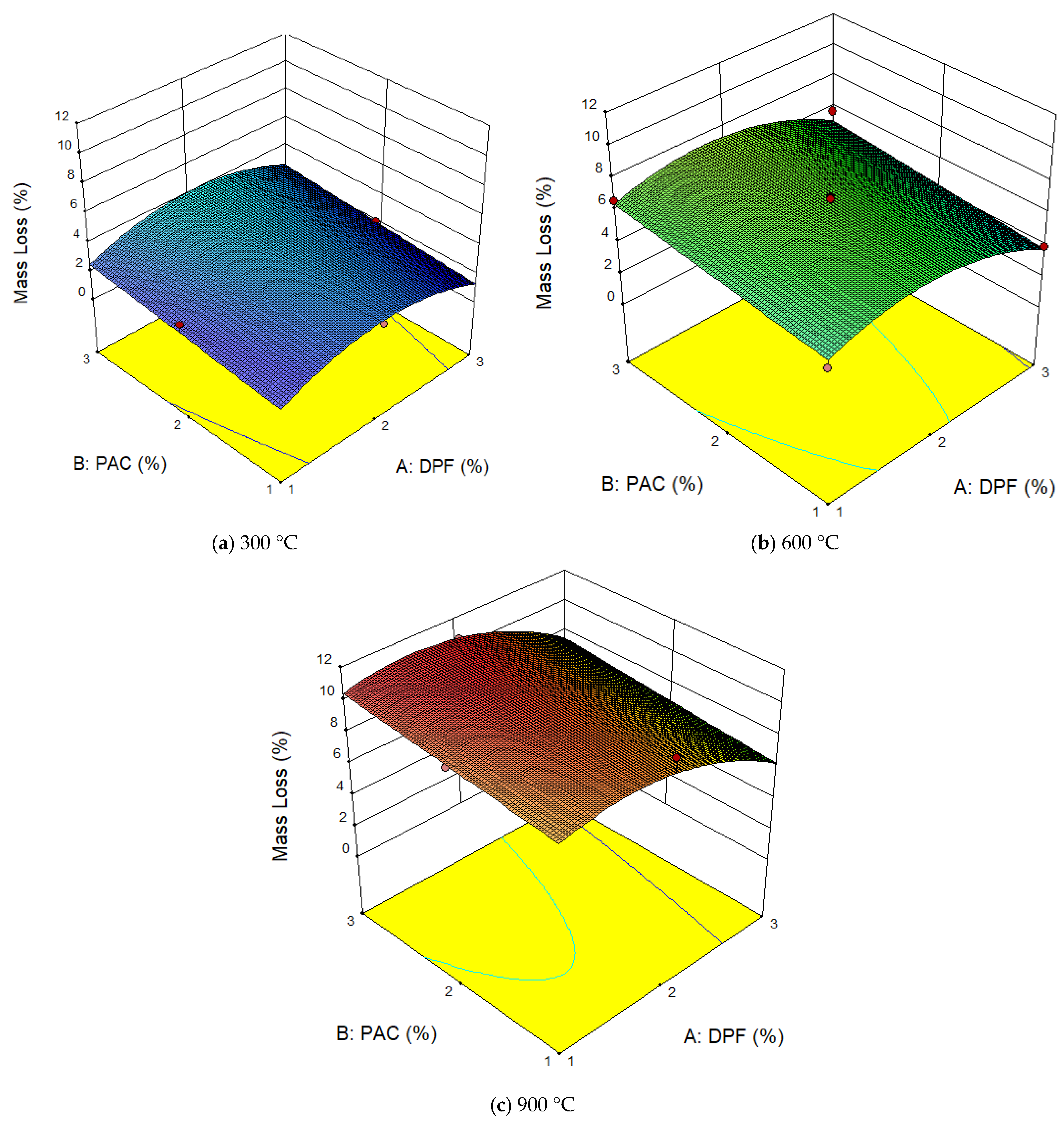
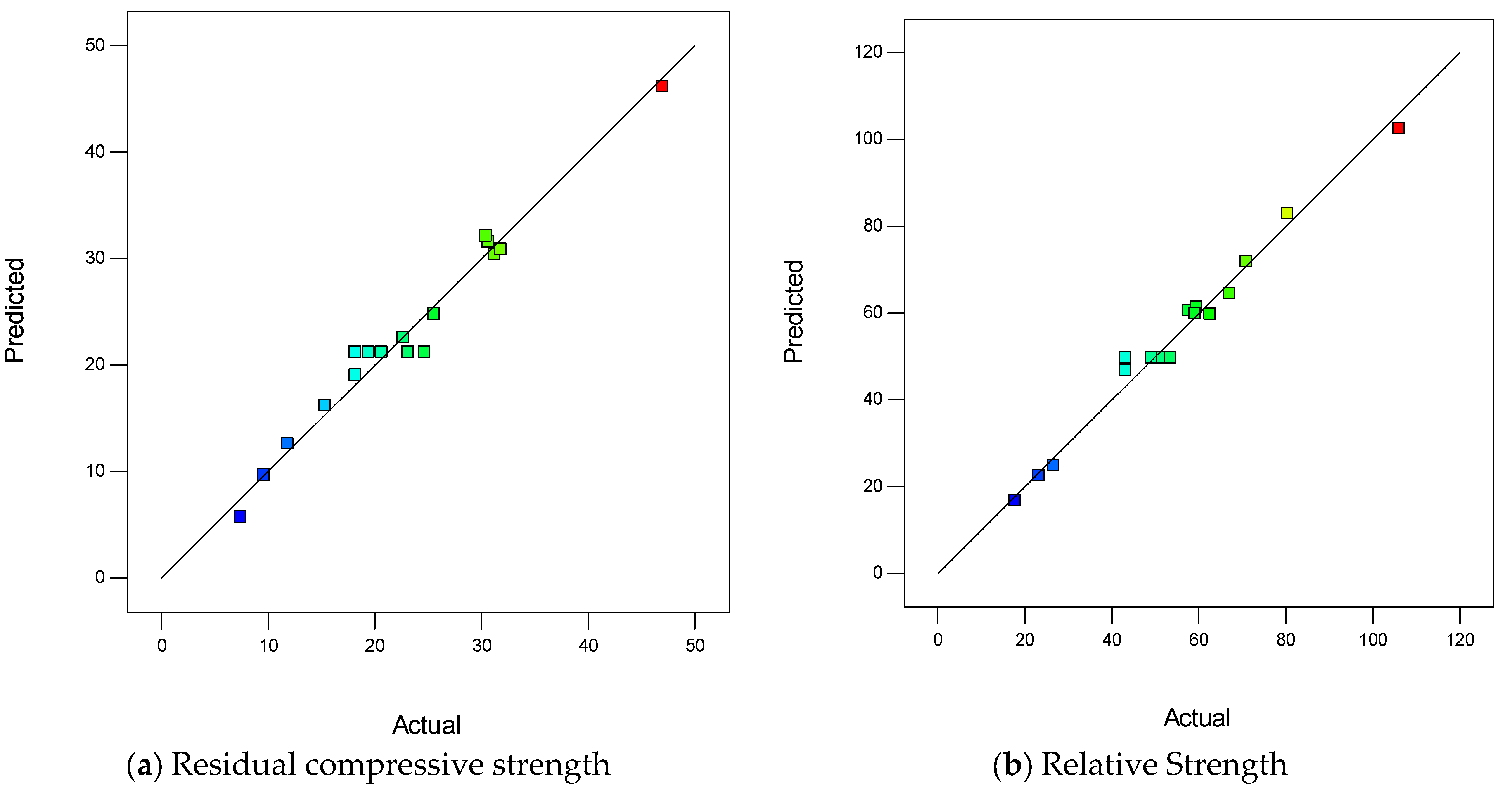

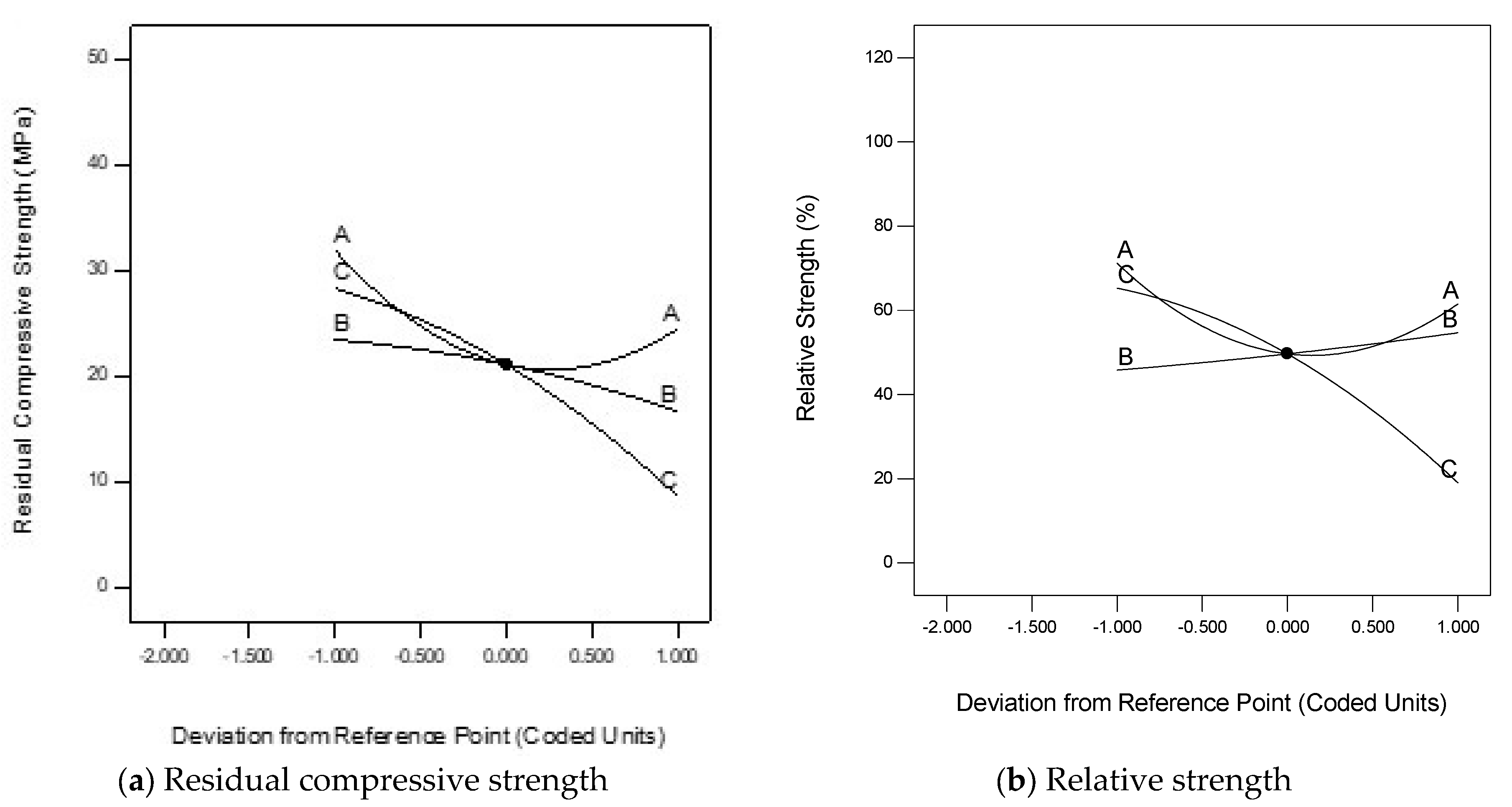
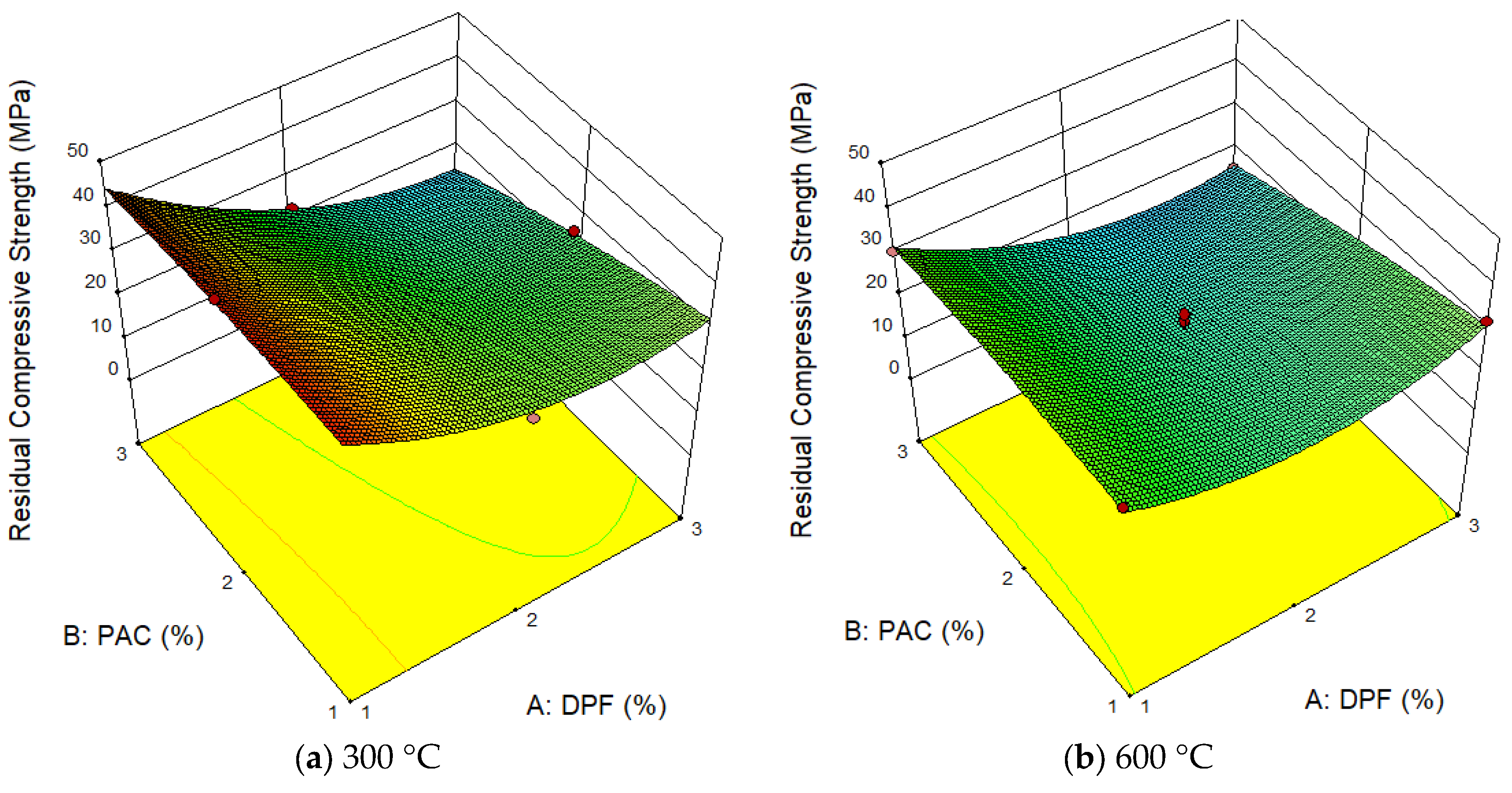
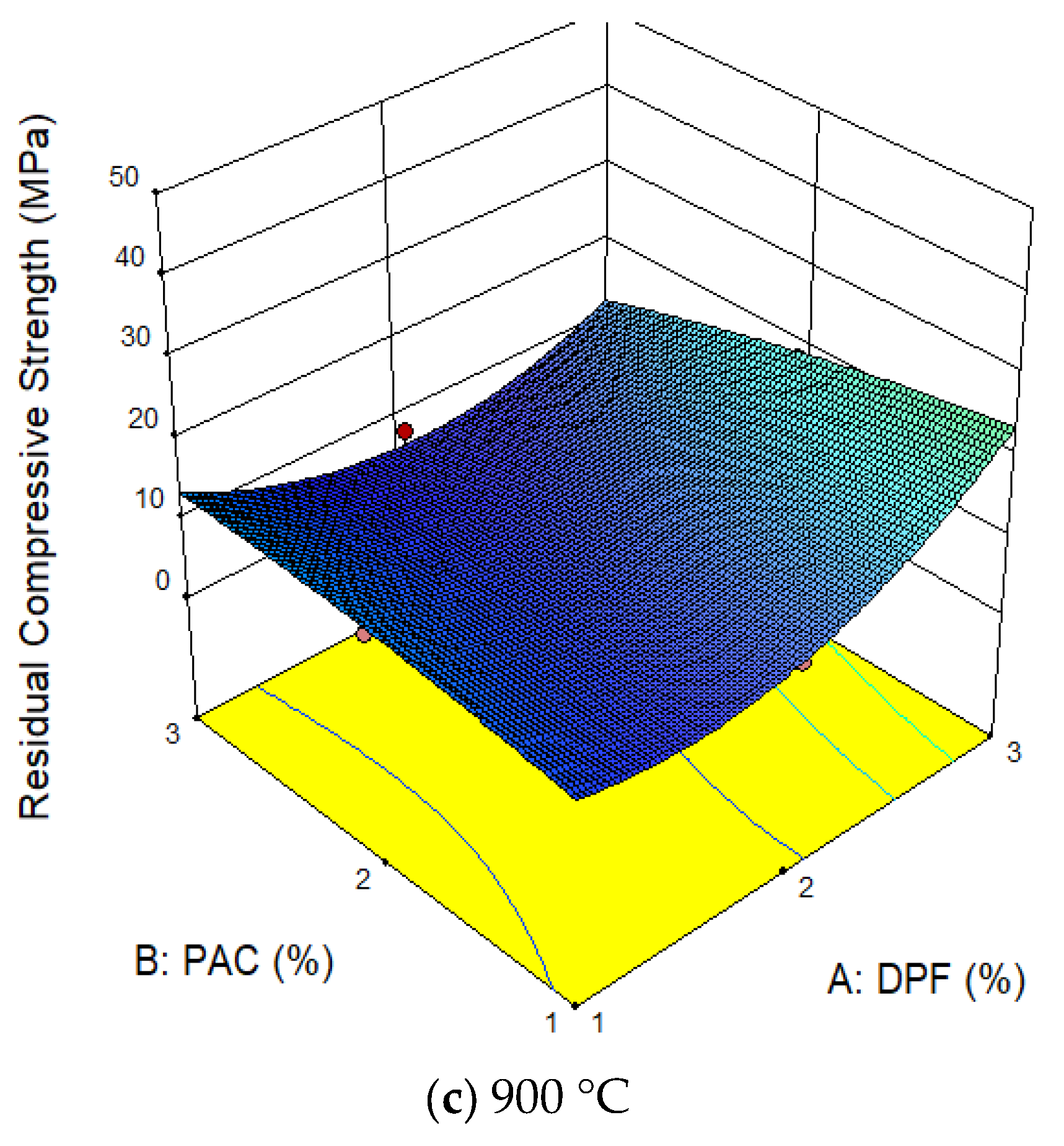

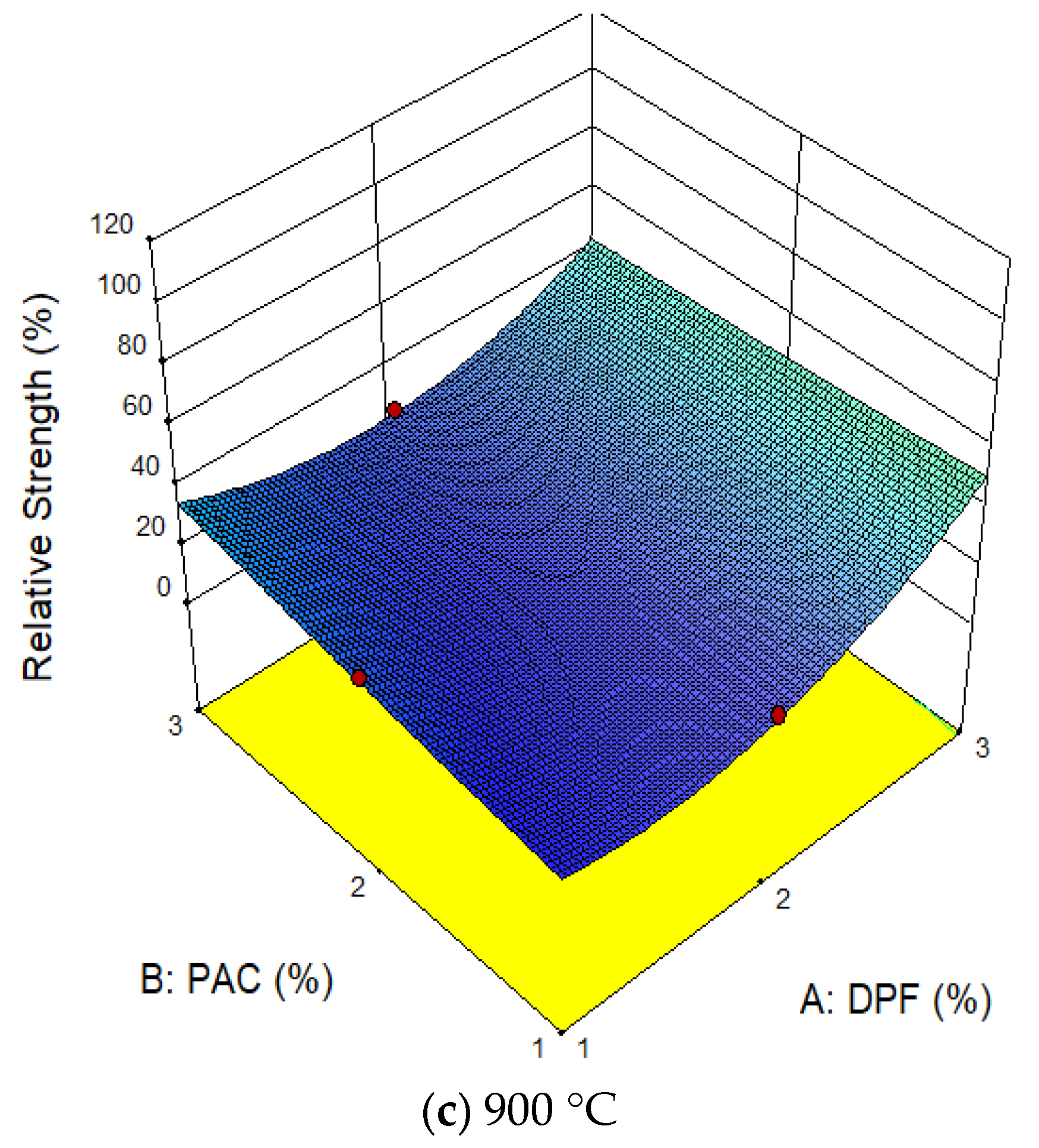
| Property | Fine Aggregate | Coarse Aggregate |
|---|---|---|
| Specific gravity | 2.63 | 2.67 |
| Bulk density (kg/m3) | 1560 | 1460 |
| Fineness modulus | 2.3 | - |
| Water absorption (%) | 1.9 | 0.7 |
| Condition | SSD | SSD |
| Run | Variables | Quantity (kg/m3) | ||||||||
|---|---|---|---|---|---|---|---|---|---|---|
| DPF | PAC | Temperature (°C) | Cement | PAC | Fiber | Fine Aggregate | Coarse Aggregate | Water | S. P | |
| Control | 0 | 0 | - | 480 | 0 | 0 | 730 | 890 | 180 | 4.8 |
| 1 | 1 | 2 | 300 | 480 | 9.6 | 4.9 | 730 | 890 | 180 | 4.9 |
| 2 | 2 | 2 | 600 | 480 | 9.6 | 9.8 | 730 | 890 | 180 | 4.9 |
| 3 | 3 | 2 | 900 | 480 | 9.6 | 14.7 | 730 | 890 | 180 | 4.9 |
| 4 | 1 | 1 | 600 | 480 | 4.8 | 4.8 | 730 | 890 | 180 | 4.9 |
| 5 | 2 | 2 | 600 | 480 | 9.6 | 9.8 | 730 | 890 | 180 | 4.9 |
| 6 | 2 | 3 | 300 | 480 | 14.4 | 9.9 | 730 | 890 | 180 | 4.9 |
| 7 | 1 | 3 | 600 | 480 | 14.4 | 4.9 | 730 | 890 | 180 | 4.9 |
| 8 | 3 | 3 | 600 | 480 | 14.4 | 14.8 | 730 | 890 | 180 | 4.9 |
| 9 | 2 | 2 | 600 | 480 | 9.6 | 9.8 | 730 | 890 | 180 | 4.9 |
| 10 | 2 | 2 | 600 | 480 | 9.6 | 9.8 | 730 | 890 | 180 | 4.9 |
| 11 | 2 | 1 | 900 | 480 | 4.8 | 9.7 | 730 | 890 | 180 | 4.9 |
| 12 | 1 | 2 | 900 | 480 | 9.6 | 4.9 | 730 | 890 | 180 | 4.9 |
| 13 | 2 | 3 | 900 | 480 | 14.4 | 9.9 | 730 | 890 | 180 | 4.9 |
| 14 | 2 | 2 | 600 | 480 | 9.6 | 9.8 | 730 | 890 | 180 | 4.9 |
| 15 | 3 | 1 | 600 | 480 | 4.8 | 14.5 | 730 | 890 | 180 | 4.9 |
| 16 | 2 | 1 | 300 | 480 | 4.8 | 9.7 | 730 | 890 | 180 | 4.9 |
| 17 | 3 | 2 | 300 | 480 | 9.6 | 14.7 | 730 | 890 | 180 | 4.9 |
| Run | Variables | Responses | |||||
|---|---|---|---|---|---|---|---|
| A: DPF | B: PAC | C: Temperature (°C) | Mass Loss (%) | Residual Compressive Strength (MPa) | Normal Compressive Strength (MPa) | Relative Strength (MPa) | |
| 1 | 1 | 2 | 300 | 2.41 | 47.01 | 44.32 | 106.07 |
| 2 | 2 | 2 | 600 | 6.92 | 18.15 | 42.15 | 43.06 |
| 3 | 3 | 2 | 900 | 6.22 | 18.19 | 41.88 | 43.16 |
| 4 | 1 | 1 | 600 | 4.68 | 31.24 | 54.13 | 57.71 |
| 5 | 2 | 2 | 600 | 6.74 | 23.12 | 45.22 | 51.13 |
| 6 | 2 | 3 | 300 | 3.74 | 22.65 | 31.95 | 70.89 |
| 7 | 1 | 3 | 600 | 6.65 | 30.63 | 38.09 | 80.41 |
| 8 | 3 | 3 | 600 | 5.74 | 15.35 | 24.53 | 62.58 |
| 9 | 2 | 2 | 600 | 6.19 | 20.64 | 40.05 | 51.54 |
| 10 | 2 | 2 | 600 | 7.01 | 24.65 | 46.1 | 53.47 |
| 11 | 2 | 1 | 900 | 10.24 | 9.6 | 54.13 | 17.73 |
| 12 | 1 | 2 | 900 | 9.56 | 11.82 | 44.32 | 26.67 |
| 13 | 2 | 3 | 900 | 10.57 | 7.42 | 31.95 | 23.22 |
| 14 | 2 | 2 | 600 | 6.88 | 19.45 | 39.63 | 49.08 |
| 15 | 3 | 1 | 600 | 3.95 | 31.81 | 47.48 | 67 |
| 16 | 2 | 1 | 300 | 2.62 | 30.4 | 51.39 | 59.16 |
| 17 | 3 | 2 | 300 | 1.98 | 25.56 | 42.96 | 59.5 |
| Source | Before Reduction | Source | After Reduction | ||||
|---|---|---|---|---|---|---|---|
| F Value | p-Value Prob > F | Significance | F Value | p-Value Prob > F | Significance | ||
| Model | 28.56 | 0.0001 | Yes | Model | 73.84 | <0.0001 | Yes |
| D-DPF | 9.04 | 0.0197 | Yes | A-DPF | 13.02 | 0.0041 | Yes |
| A-PAC | 8.39 | 0.0231 | Yes | B-PAC | 12.08 | 0.0052 | Yes |
| T-Temperature | 206.33 | <0.0001 | Yes | C-Temperature | 297.07 | <0.0001 | Yes |
| D*A | 0.020 | 0.8915 | No | — | — | — | — |
| D*T | 5.23 | 0.0560 | No | AC | 7.54 | 0.0191 | Yes |
| A*T | 0.39 | 0.5542 | No | — | — | — | — |
| D2 | 27.37 | 0.0012 | Yes | A2 | 39.51 | <0.0001 | Yes |
| A2 | 0.17 | 0.6909 | No | — | — | — | — |
| T2 | 0.073 | 0.7942 | No | — | — | — | — |
| Lack of Fit | 7.51 | 0.0404 | Yes | Lack of Fit | 3.56 | 0.1184 | No |
| Term | Before Reduction | After Reduction |
|---|---|---|
| R2 | 0.974 | 0.971 |
| Adjusted R2 | 0.939 | 0.958 |
| Predicted R2 | 0.634 | 0.893 |
| Adequate Precision | 17.89 | 27.89 |
| Standard Deviation | 0.64 | 0.53 |
| Mean | 6.01 | 6.01 |
| Coefficient of variation (%) | 10.59 | 8.83 |
| Residual Compressive Strength (MPa) | Relative Strength (%) | ||||||
|---|---|---|---|---|---|---|---|
| Source | F Value | p-Value Prob > F | Significance | Source | F Value | p-Value Prob > F | Significance |
| Model | 28.68 | 0.0001 | Yes | Model | 43.62 | <0.0001 | Yes |
| D-DPF | 19.42 | 0.0031 | Yes | D-DPF | 10.22 | 0.0151 | Yes |
| A-PAC | 15.95 | 0.0052 | Yes | A-PAC | 8.63 | 0.0218 | Yes |
| T-Temperature | 135.15 | <0.0001 | Yes | T-Temperature | 234.00 | <0.0001 | Yes |
| D*A | 10.99 | 0.0128 | Yes | D*A | 10.07 | 0.0156 | Yes |
| D*T | 33.87 | 0.0007 | Yes | D*T | 54.47 | 0.0002 | Yes |
| A*T | 1.36 | 0.2821 | No | A*T | 0.53 | 0.4889 | No |
| D2 | 37.07 | 0.0005 | Yes | D2 | 64.22 | <0.0001 | Yes |
| A2 | 0.79 | 0.4033 | No | A2 | 0.079 | 0.7870 | No |
| T2 | 5.17 | 0.0572 | No | T2 | 12.94 | 0.0088 | Yes |
| Lack of Fit | 0.55 | 0.6731 | No | Lack of Fit | 1.32 | 0.3837 | No |
| Term | Residual Compressive Strength (MPa) | Relative Strength (%) |
|---|---|---|
| R2 | 0.974 | 0.983 |
| Adjusted R2 | 0.94 | 0.960 |
| Predicted R2 | 0.847 | 0.847 |
| Adequate Precision | 22.06 | 26.18 |
| Standard Deviation | 2.39 | 4.27 |
| Mean | 22.81 | 54.26 |
| C.V. % | 10.48 | 7.87 |
| Variables/Responses | Goal | Lower Limit | Upper Limit | Solutions | ||
|---|---|---|---|---|---|---|
| No. 1 | No. 2 | No. 3 | ||||
| D: DPF (%) | In range | 1 | 3 | 1.0 | 1.0 | 1.0 |
| A:PAC (%) | In range | 1 | 3 | 2.27 | 2.31 | 2.32 |
| T: Temperature (°C) | In range | 300 | 900 | 300 | 305.4 | 311.3 |
| Mass loss (%) | Minimize | 1.98 | 10.57 | 2.05 | 2.14 | 2.23 |
| Residual Compressive Strength (MPa) | Maximize | 7.42 | 47.01 | 45.85 | 45.60 | 45.36 |
| Relative Strength (%) | maximize | 17.73 | 106.07 | 106.7 | 106.1 | 105.8 |
| Desirability (%) | 98.8 | 98.2 | 97.5 | |||
| Responses | Variables | Predicted | Experimental | Error | Mean Error (%) | ||
|---|---|---|---|---|---|---|---|
| DPF | PAC | Temp | |||||
| Mass loss | 1 | 2.27 | 300 | 2.03 | 2.16 | 5.84 | 6.79 |
| 1 | 2.32 | 311.3 | 2.22 | 2.1 | 5.48 | ||
| 2 | 1 | 600 | 6.10 | 6.52 | 6.52 | ||
| 3 | 1 | 900 | 6.29 | 6.93 | 9.31 | ||
| 1 | 1 | 400 | 2.52 | 2.75 | 8.22 | ||
| 1.5 | 2.5 | 700 | 8.20 | 8.67 | 5.38 | ||
| Residual Compressive Strength | 1 | 2.27 | 300 | 45.75 | 43.27 | 5.72 | 6.66 |
| 1 | 2.32 | 311.3 | 45.25 | 47.19 | 4.11 | ||
| 2 | 1 | 600 | 23.14 | 25.3 | 8.53 | ||
| 3 | 1 | 900 | 23.04 | 21.46 | 7.38 | ||
| 1 | 1 | 400 | 41.18 | 43.5 | 5.33 | ||
| 1.5 | 2.5 | 700 | 18.90 | 20.74 | 8.88 | ||
| Relative Strength | 1 | 2.27 | 300 | 113.23 | 105.6 | 7.23 | 7.06 |
| 1 | 2.32 | 311.3 | 113.39 | 120.2 | 5.66 | ||
| 2 | 1 | 600 | 52.57 | 57.3 | 8.26 | ||
| 3 | 1 | 900 | 61.78 | 57.3 | 7.82 | ||
| 1 | 1 | 400 | 86.39 | 91.6 | 5.69 | ||
| 1.5 | 2.5 | 700 | 67.55 | 73.2 | 7.72 | ||
Disclaimer/Publisher’s Note: The statements, opinions and data contained in all publications are solely those of the individual author(s) and contributor(s) and not of MDPI and/or the editor(s). MDPI and/or the editor(s) disclaim responsibility for any injury to people or property resulting from any ideas, methods, instructions or products referred to in the content. |
© 2023 by the authors. Licensee MDPI, Basel, Switzerland. This article is an open access article distributed under the terms and conditions of the Creative Commons Attribution (CC BY) license (https://creativecommons.org/licenses/by/4.0/).
Share and Cite
Adamu, M.; Ibrahim, Y.E.; Elalaoui, O.; Alanazi, H.; Ali, N.M. Modeling and Optimization of Date Palm Fiber Reinforced Concrete Modified with Powdered Activated Carbon under Elevated Temperature. Sustainability 2023, 15, 6369. https://doi.org/10.3390/su15086369
Adamu M, Ibrahim YE, Elalaoui O, Alanazi H, Ali NM. Modeling and Optimization of Date Palm Fiber Reinforced Concrete Modified with Powdered Activated Carbon under Elevated Temperature. Sustainability. 2023; 15(8):6369. https://doi.org/10.3390/su15086369
Chicago/Turabian StyleAdamu, Musa, Yasser E. Ibrahim, Oussama Elalaoui, Hani Alanazi, and Nageh M. Ali. 2023. "Modeling and Optimization of Date Palm Fiber Reinforced Concrete Modified with Powdered Activated Carbon under Elevated Temperature" Sustainability 15, no. 8: 6369. https://doi.org/10.3390/su15086369






